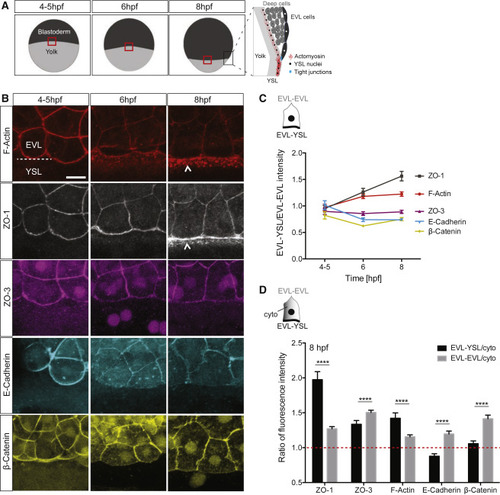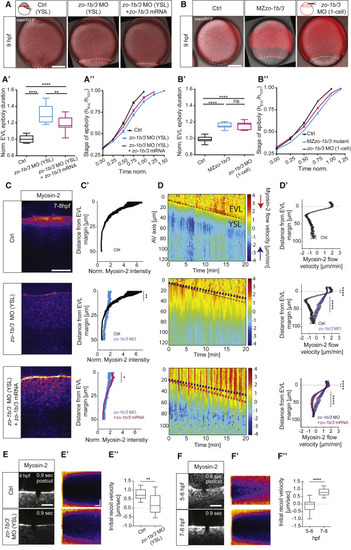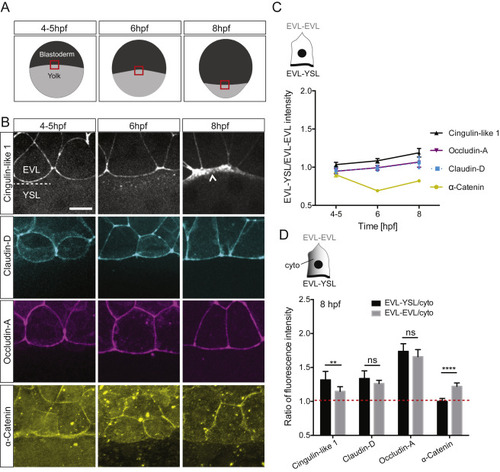- Title
-
Mechanosensation of Tight Junctions Depends on ZO-1 Phase Separation and Flow
- Authors
- Schwayer, C., Shamipour, S., Pranjic-Ferscha, K., Schauer, A., Balda, M., Tada, M., Matter, K., Heisenberg, C.P.
- Source
- Full text @ Cell
|
TJ Components Accumulate at the EVL-YSL Boundary (A) Schematic representation of enveloping cell layer (EVL) spreading during consecutive stages of epiboly (4–5, 6, and 8 hpf). Yolk cell, light gray; blastoderm (EVL and deep cells), dark gray. The black rectangle demarcates the region of the enlarged sagittal view outlining the tissue structure at 8 hpf. The red rectangle demarcates regions of the EVL-YSL boundary shown in (B). (B) Maximum intensity projections (MIPs) of F-actin, ZO-1, ZO-3, E-cadherin, and β-catenin localization at the EVL-YSL boundary at 4–5, 6, and 8 hpf. ZO-1, ZO-3, E-cadherin, and β-catenin were detected by immunohistochemistry, and F-actin by Phalloidin. White arrowheads point to increased accumulation at the EVL-YSL boundary. Scale bar, 20 μm. (C) Plot of EVL-YSL junctional intensity normalized to EVL-EVL junctional intensity as a function of time during EVL epiboly (see also schematic above). Data are mean at 95% confidence. F-actin with N = 2, n = 15 at 4–5 hpf, n = 42 at 6 hpf, and n = 46 at 8 hpf. ZO-1 with N = 2, n = 15 at 4–5 hpf, n = 42 at 6 hpf, and n = 46 at 8 hpf. ZO-3 with N = 2, n = 26 at 4–5 hpf, n = 52 at 6 hpf, and n = 58 at 8 hpf. E-cadherin with N = 3, n = 29 at 4–5 hpf; with N = 2, n = 32 at 6 hpf; and with N = 3, n = 84 at 8 hpf. β-Catenin with N = 2, n = 54 at 4–5 hpf, n = 29 at 6 hpf, and n = 28 at 8 hpf. (D) Plot of EVL-YSL junctional intensity (black) and EVL-EVL junctional intensity (gray) normalized to cytoplasmic intensity at 8 hpf. The red dashed line indicates a ratio of 1, demarcating the boundary between accumulation (>1) and depletion (<1). Data are mean at 95% confidence. N/n same as in (C), except for E-cadherin with N = 2, n = 40. Mann-Whitney test for F-Actin, ZO-3, and E-cadherin; unpaired t test for ZO-1 and β-catenin. ∗∗∗∗p < 0.0001; n, number of cells. See also Figure S1. EXPRESSION / LABELING:
|
|
ZO-1b and 3 Are Required for Proper EVL Epiboly Movements and Actomyosin Flows and Tension within the YSL (A and B) MIPs of bright-field/fluorescence images of embryos injected directly into the YSL at 3.3 hpf with phenol red and H2A-mcherry mRNA as control (Ctrl), zo-1b and zo-3 MOs, and zo-1b/3 MOs together with GFP-tagged zo-1b and zo-3 mRNA (mutated for the MO recognition site) at 9 hpf (A) and wild-type control embryos (Ctrl) and MZzo-1b/3 mutant and 1-cell zo-1b/3 morphant embryos at 9 hpf (B). The plasma membrane is marked by membrane-RFP (red fluorescent protein) to outline cells. The EVL-YSL boundary is marked by a white dashed line to demarcate the extent of EVL epiboly under the different conditions. Schemes of different injection methods show injection into the YSL (A) to obtain YSL-specific knockdown and into the 1-cell stage embryo (B) to gain ubiquitous knockdown. Scale bar, 200 μm. (A’ and B’) Plot of the total time required for EVL to complete epiboly for the conditions shown in (A) and (B) and normalized to the average time needed by Ctrl embryos. (A’) YSL-Ctrl with N = 3, n = 11; YSL-morphant with N = 3, n = 12; YSL morphant rescue with N = 3, n = 11. (B’) Wild-type (WT) Ctrl with N = 4, n = 11; 1-cell stage injected Ctrl for morphant with N = 3, n = 11; mutant with N = 4, n = 13; 1-cell morphant with N = 3, n = 8. Data are shown as box-and-whisker plots (whiskers, Tukey); one-way ANOVA with Tukey’s multiple comparisons test. (A’’ and B’’) Plot of EVL tissue spreading, expressed as height of EVL (hEVL) normalized to total embryo height (hTOT) as a function of time normalized to the average time needed by Ctrl embryos for the conditions shown in (A) and (B). N/n as in (A’) and (B’). Data are mean ±SEM. (C) MIPs of Myosin-2 localization at the EVL-YSL boundary in Tg(actb1:myl12.1-eGFP) or Tg(actb1:myl12.1-mcherry) YSL-Ctrl (phenol red injected), zo-1b/3 YSL-morphant, and zo-1b/3 YSL-morphant embryos rescued by co-injection of GFP-tagged zo-1b and zo-3 (mutated for the MO recognition site) mRNAs at 7–8 hpf. Scale bar, 20 μm. (C’) Plot of Myosin-2 intensity as a function of distance from the EVL margin in YSL-Ctrl, zo-1b/3 YSL-morphant, and rescued zo-1b/3 YSL-morphant embryos at 7–8 hpf. Fluorescence intensity was normalized to the EVL cortical signal. Data are mean ± SEM; unpaired t test; YSL-Ctrl with N = 4, n = 8 and zo-1b/3 YSL-morphant with N = 5, n = 8; rescued zo-1b/3 YSL-morphant with N = 6, n = 13. (D) Kymograph of Myosin-2 flow velocities along the animal-vegetal (AV) axis of the embryo as a function of time during epiboly in an exemplary YSL-Ctrl, zo-1b/3 YSL-morphant and rescued zo-1b/3 YSL-morphant embryo at 7–8 hpf. The kymograph ranges from negative values (blue and blue arrow) indicating retrograde flows toward the EVL margin to positive values (red and red arrow) indicating anterograde flows toward the vegetal pole. Dashed lines mark the slope of EVL movement (black, YSL-Ctrl; blue, zo-1b/3 YSL-morphant; pink, rescued zo-1b/3 YSL-morphant embryos). The EVL is located above the dashed line and the YSL below. (D’) Plot of Myosin-2 mean flow velocities along the AV axis, averaged over 5–30 min in YSL-Ctrl, zo-1b/3 YSL-morphant, and rescued zo-1b/3 YSL-morphant embryos between 7 and 8 hpf. Data are mean ± SEM. EVL peak velocities were averaged over 10 μm; unpaired t test. YSL peak velocities were averaged over 45 μm (15–60 μm from the EVL margin); Mann-Whitney test; N/n same as in (C’). (E and F) MIPs of the EVL-YSL boundary in Myosin-2-expressing Tg(actb1:myl12.1-eGFP) YSL-Ctrl and zo-1b/3 YSL-morphant embryos at 7–8 hpf (E) and Tg(actb1:myl12.1-eGFP)-expressing WT embryos at 6 and 8 hpf (F) after UV laser cutting (fourth post-cut frame) along a 5-μm line oriented perpendicular to the boundary. Scale bar, 10 μm. (E’ and F’) Exemplary kymographs of EVL-YSL junctional opening in response to UV laser cutting as a function of time for the conditions shown in (E) and (F). Horizontal scale bar, 1.2 s; vertical scale bar, 1 μm. (E’’ and F”) Plot of initial recoil velocities of EVL-YSL junctions after UV laser cutting for the conditions shown in (E) and (F). Data are shown as box-and-whisker plots (whiskers, Tukey); unpaired t test; YSL-Ctrl and zo-1b/3 YSL-morphant with each N = 2, n = 12; WT embryos at 6 hpf and 8 hpf with each N = 3, n = 17. ∗∗∗∗p < 0.0001, ∗∗∗p < 0.001, ∗∗p < 0.01, ∗p < 0.05; n, number of embryos. See also Figure S2 and Videos S1 and S2. PHENOTYPE:
|

ZFIN is incorporating published figure images and captions as part of an ongoing project. Figures from some publications have not yet been curated, or are not available for display because of copyright restrictions. EXPRESSION / LABELING:
|

ZFIN is incorporating published figure images and captions as part of an ongoing project. Figures from some publications have not yet been curated, or are not available for display because of copyright restrictions. |
|
TJ and AJ Component Localization at the EVL-YSL Boundary, Related to Figure 1 (A) Schematic representation of EVL spreading during consecutive stages of epiboly (4-5, 6 and 8 hpf). Yolk cell, light gray; blastoderm (EVL and deep cells), dark gray. Red rectangle demarcates regions of the EVL-YSL boundary shown in (B). (B) Maximum intensity projections (MIPs) of GFP-Cingulin-like 1, GFP-Claudin-D, Occludin-A-mNeonGreen and α-Catenin localization at the EVL-YSL boundary at 4-5, 6 and 8 hpf. α-Catenin is visualized by immunohistochemistry, Cingulin-like 1 and Claudin-D and Occludin-A by expression of their respective GFP- or mNEONgreen-fusion constructs, respectively, in wild-type embryos. White arrowheads point to increased accumulation at the EVL-YSL boundary. Scale bar, 20 μm. (C) Plot of EVL-YSL junctional intensity normalized to EVL-EVL junctional intensity as a function of time during EVL epiboly (see also schematic above). Data are mean at 95% confidence. Cingulin-like 1 with N = 2, n = 33 at 4-5 hpf, n = 37 at 6 hpf and n = 31 at 8 hpf. Claudin-D with N = 2, n = 40 at 4-5 hpf, n = 50 at 6 hpf, n = 29 at 8 hpf. Occludin-A with N = 2, n = 27 at 4-5 hpf; N = 2, n = 54 at 6 hpf; N = 3, n = 43 at 8 hpf. α-Catenin with N = 2, n = 45 at 4-5 hpf, n = 29 at 6 hpf, n = 28 at 8 hpf. (D) Plot of EVL-YSL junctional intensity (black) and EVL-EVL junctional intensity (gray) normalized to cytoplasmic intensity at 8 hpf. Red dashed line indicates ratio of 1 demarcating the boundary between accumulation (> 1) and depletion (< 1). Data are mean at 95% confidence. Cingulin-like 1 with N = 2, n = 30. Claudin-D with N = 2, n = 29 cells. Occludin-A with N = 3, n = 43. α-Catenin with N = 2, n = 28. Cingulin-like 1, Claudin-D and Occludin-A with Mann-Whitney test. α-Catenin with Unpaired t test. ∗∗∗∗p < 0.0001; ∗∗p < 0.01; ns, not significant; n, number of cells. |
|
zo-1b/3 Mutant and Morphant Analysis, Related to Figure 2 (A) Plot of total time required for EVL to complete epiboly normalized to the average time needed by control (Ctrl) embryos injected with either phenol-red (Ctrl), zo-1b/3 5-base mismatch Ctrl MO (5mm-MO) or standard negative Ctrl MO (Std MO) into the YSL. Data are mean ± s.e.m. Kruskal-Wallis test with Dunn’s multiple comparisons test. Ctrl with N = 4, n = 14; zo-1b/3 MO with N = 3, n = 12; standard control MO with N = 3, n = 11. (B) Dorsal view of YSL-injected Ctrl (phenol-red, YSL-Ctrl) and zo-1b/3 morphant (YSL-morphant) embryos at 1-somite stage (10.5 hpf) labeled by in situ hybridization for papc outlining the forming somites. Scale bar, 200 μm. (B’) Bar plot of stage distribution (categorized in 0 and 1 somite stages as revealed by papc in situ hybridization) for the conditions described in (B). Data are mean ± s.e.m. 80% of Ctrl-YSL embryos and 69% of zo-1b/3 YSL-morphants showed 1 somite at 10.5 hpf. Mann-Whitney test. YSL-Ctrl with N = 3, n = 36; YSL-morphant with N = 3, n = 45. (C) Mutation sites in MZzo-1b and MZzo-3 mutants. Red triangles indicate the insertion sites of the STOP codon. (D) Plot of EVL tissue spreading, expressed as height of EVL (hEVL) normalized to total embryo height (hTOT), as a function of time normalized to average time needed by Ctrl embryos shown for wild-type (wt) Ctrl, and MZzo-1b and MZzo-3 single mutants. Data are mean ± s.e.m. One-way ANOVA with Tukey’s multiple comparisons test. Wt (Ctrl) with N = 4, n = 27; MZzo-1b with N = 3, n = 16; and MZzo-3 with N = 3, n = 18. (E) Dorsal view of Ctrl (phenol-red, Ctrl) and zo-1b/3 morphant embryos injected at the 1-cell stage, and of wt and MZzo-1b/3 mutant embryos labeled at 10.5 hpf by in situ hybridization for papc outlining the forming somites. Scale bar, 200 μm. (E’) Plot of stage distribution (categorized in 0, 1 and 2-somite stages as revealed by papc in situ hybridization) for the condition described in (E). 86% of Ctrl, 67% of MZzo-1b/3 embryos and 73% of zo-1b/3 morphants showed 1 somite at 10.5 hpf. Data are mean ± s.e.m. Cumulative link mixed model was used to determine p values in R. Ctrl versus MZzo-1b/3 mutants with p = 0.0002 and Ctrl versus zo-1b/3 morphants with p = 0.04. Ctrl with N = 2, n = 26; morphant with N = 3, n = 43; wt Ctrl with N = 4, n = 72 and mutant with N = 5, n = 77. (F) Maximum intensity projections (MIPs) of ZO-1 (left column), ZO-3 (middle column) and E-cadherin (right column) localization at the EVL-YSL boundary in YSL-Ctrl (upper row) and zo-1b/3 YSL-morphant (lower row) embryos at 8 hpf. ZO-1, ZO-3 and E-Cadherin were detected by immunohistochemistry. Scale bar, 20μm. (F’) Plot of EVL-YSL junctional intensity normalized to EVL-EVL junctional intensity at 8 hpf for the conditions described in (F). Data are mean ± s.e.m. Statistical test for ZO-1 intensity with Mann-Whitney test, ZO-3 intensity with unpaired t test and E-Cadherin intensity with unpaired t test; ZO-1: N = 2, YSL-Ctrl with n = 30 and zo-1b/3 YSL-morphant with n = 40; ZO-3: N = 2, YSL-Ctrl with n = 42 and zo-1b/3 YSL-morphant with n = 59. E-Cadherin: N = 3, Ctrl with n = 51 and zo-1b/3 YSL-morphant with n = 54. (G) MIPs of ZO-1, ZO-3 and F-actin localization at the EVL-YSL boundary in wt and MZzo-1b/3 mutant embryos at 8 hpf. ZO-1 and ZO-3 were detected by immunohistochemistry, and F-actin by Phalloidin. ZO-1 antibody likely detects both zebrafish ZO-1a and ZO-1b, suggesting that the remaining signal in the MZzo-1b/3 mutant reflects ZO-1a protein expression. (G’) Plot of EVL-YSL junctional intensity normalized to EVL-EVL junctional intensity, and EVL-YSL junctional intensity together with EVL-EVL junctional intensity normalized to cytoplasmic intensity at 8 hpf for the conditions shown in (G). Data are mean ± s.e.m. Statistical test for ZO-1: EVL-YSL/EVL-EVL with Mann-Whitney test, and EVL-YSL/cyto and EVL-EVL/cyto with unpaired t test; ZO-3: EVL-YSL/cyto and EVL-EVL/cyto with unpaired t test. N = 2, wt with n = 31 and MZzo-1b/3 mutant with n = 33. (G’’) Plot of F-Actin fluorescence intensity within the YSL as a function of distance from EVL margin for the conditions described in (D). F-actin was detected by Phalloidin. Data are mean ± SEM. [a.u.], arbitrary units. N = 2, wt with n = 7 and MZzo-1b/3 mutant with n = 7. (H) Compensatory expression changes of zo genes in MZzo-1b/3 mutant embryos normalized to the expression level of a housekeeping gene (elongation factor 1α). Fold change reflects the relative change of expression levels in MZzo-1b/3 mutant compared to wt embryos in qRT-PCR. Data are mean ± SEM. Red solid line indicates 1-fold change in expression, demarcating the boundary between increase (> 1) and decrease (< 1) of expression levels of the five different zo genes (N = 3). (I and J) Plot of junctional opening (distance in μm) of the EVL-YSL boundary marked by Myosin-2-GFP after UV laser cutting at late (8 hpf) stage of EVL epiboly in YSL-Ctrl and zo-1b/3 YSL-morphant (I) embryos and in wt embryos (J) at mid (6 hpf) and late (8 hpf) stages of EVL epiboly as a function of time after cutting. Data are mean ± SEM. Red dashed boxes indicate regions for calculation of initial recoil velocity shown in (I’,J’). (I’ and J’) Plot of the first four time-points from (I,J) with linear fit to extract initial recoil velocity shown in Figures 2E’’ and 2F’’). Data are mean ± SEM. N,n see (Figures 2E–2F). ∗∗∗∗p < 0.0001; ∗∗p < 0.01; ns, not significant; n, number of embryos (A, B’, D, E’, and G’’) and cells (F’ and G’). |
Reprinted from Cell, 179, Schwayer, C., Shamipour, S., Pranjic-Ferscha, K., Schauer, A., Balda, M., Tada, M., Matter, K., Heisenberg, C.P., Mechanosensation of Tight Junctions Depends on ZO-1 Phase Separation and Flow, 937-952.e18, Copyright (2019) with permission from Elsevier. Full text @ Cell




